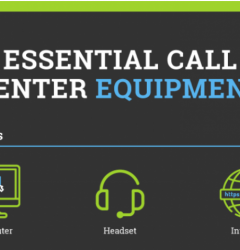13 Jan

As a manager, it can be hard to track the progress and results of the operations in the company. That’s why call metrics come in handy! Save yourself time and money by implementing these 9 call center metrics.
Call Metric #1: Calls Until a Conversion
Your agents call anywhere from 50-80 prospects a day, but how many of those result in a conversion or meeting? While you want your agents to call as many people as possible, it is more important that they move prospects further down the sales pipeline. By tracking how many calls it takes until a prospect becomes a customer, you can tell a lot about your leads quality as well as your agents skills.
Example
If it takes ten or more calls to secure a sale, you can either assume that the leads are not well suited for the company or that your agents need further training. Keep in mind these tips on talking to customers as you train your staff.
Call Metric #2: Calls per Hour
The most basic form of metric for the sales industry is measuring how many calls are made each hour by your agents. This gives you an idea of what each agent is capable of doing and helps you assess new goals for them to strive for in the future. This metric can be tracked through a power dialer so every call is automatically stored in a data report, checking one more thing off your to do list.
Example
If you see that your sales team made a certain number of calls in February of last year, you can expect the same number or more, if you set a goal to beat last year’s calling number.
Call Metric #3: Call Outcome
This calling metric tracks the outcome of the call: answered and had a discussion, answered but hung up, voicemail, or disconnected. Not only is this important for knowing which numbers are no good but it’s also an indicator of how successful your sales dialogue and caller ID appeal to prospects.
Example
Through tracking your call outcomes you might find that over 20% of the calls go straight to voicemail. This would indicate that the numbers are good numbers but your caller ID might need to change in order to peak the prospects interest.
Call Metric #4: Follow-up per Lead
Sales are hardly ever a one call and done situation. Your sales team has to strengthen the customer to business relationship through follow-up calls and emails periodically. Through this, salespeople can encourage the prospects to purchase by using the customer notes from the first call. Initiating that follow-up call and discussing the concern/questions that the prospect had in the first call shows the prospect that you listened and cared about what’s important to them. The follow-up call or email is all about reassuring them, catering to their needs, and peaking their interest to lead to another call, meeting or sale.
Example
On average five calls take place after a meeting. This means your sales team shouldn’t deem the lead a bad lead after four calls. The more communication, the more a prospect trusts the company and the more likely that they will purchase from you.
Call Metric #5: Voicemail Returns
This measures the effectiveness of your company’s voicemail script. Monitoring the responses to the voicemail, will help your company see what sales tactics work and which ones don’t. Whenever the voicemail script is revised it will also be helpful to compare the response number to the new one as compared to the old one. This process can be repeated until you find a voicemail script that gives you the number of responses you aim to get.
Example
If you find that less than 70% of the prospects who received voicemails respond, it is an indication that the voicemail script does not gain customers attention as it should. For the percentage of callers who do respond to the voicemail, refer to this article on how to generate leads out of inbound calls.
Call Metric #6: Handle Time
Research shows that over 60% of customers resolve issues and concerns over the phone. Since that’s the case your company will want to measure how long a customer was on the phone with the agent. Keeping the customer on the phone longer allows the agent to answer any concerns they might have and gives them time to gain more information from the customer as well.
Example
You might notice that an agent spends less than a minute talking to each customer. In this case, the agent might need more training on how to keep the prospect on the phone longer in order to ask them questions and share more about the product.
For more call center statistics and information on how to better handle sales calls you can read our detailed article on tracking call center performance.
Call Metric #7: Agent Satisfaction
This metric measures how well the agents think each call went. The scale of options should be simple so it isn’t time consuming. You simply want to know if the call went well or not. This metric can later be used as a teaching tool if you find that certain agents tend to have negative calls.
Example
Once agents get off the phone call, it would be convenient to have a scale of options to quickly choose from, indicating how the call went. The scale can be as simple as negative, neutral, or positive.
Call Metric #8: Cost per Call
In a sales department one of the major expenses is outbound calls. This call center metric is an industry standard used for measuring how much a single call costs and helps with tracking or predicting expenses.
Example
There are two ways to measure this metric. The first is by taking the agents hourly wage and dividing it by their calls per hour. Another way this can be done is by dividing the annual hourly wage and the annual calls.
Call Metric #9: Number of Metrics You Are Tracking
Unless you have a team dedicated to tracking your data, don’t expend too much of your time on analyzing and tracking data. The metrics you track should be a necessity for your business, not a luxury, unless of course you have the manpower to track it all.
Example
Keep your metrics in the teen range to keep it manageable and useful to the company. Once you pass twenty or more they tend to be mismanaged and lose their usefulness.
You should definitely consider these metrics as part of the quality control for your sales strategy. If you think it needs a little refreshment, read our article on building a great sales strategy.
Works Cited
Brandon, L., 2021. Call Center Tracking | EVS7. [online] EVS7. Available at: <https://www.evs7.com/blog/call-center-tracking> [Accessed 6 January 2021].
Paton, T., 2021. 27 Awesome Call Centre Metrics | Industry Standard Kpis. [online] contactSPACE. Available at: <https://www.contactspace.com/blog/call-centre-metrics> [Accessed 6 January 2021].
Brandon, L., 2021. Inbound Calls | Generate Leads | Call Center Tactics | EVS7. [online] EVS7. Available at: <https://www.evs7.com/blog/how-to-generate-leads-through-inbound-calls> [Accessed 9 January 2021].
Martin, J., 2021. What Is Average Handle Time (AHT): How To Reduce & Calculate AHT. [online] Zendesk. Available at: <https://www.zendesk.com/blog/average-handle-time/> [Accessed 9 January 2021].
Brandon, L., 2021. Tips For Talking To Customers On The Phone | Electronic Voice Services. [online] EVS7. Available at: <https://www.evs7.com/call-center/talk-to-customers-on-the-phone> [Accessed 8 January 2021].
Recent Posts
Categories
- answering service (8)
- blog (8)
- call center (67)
- sales (45)
- tas (1)
- technology (3)
- telemarketing (1)
- Uncategorized (3)
Archives
- January 2025
- April 2022
- March 2022
- February 2022
- January 2022
- December 2021
- November 2021
- October 2021
- September 2021
- August 2021
- May 2021
- April 2021
- March 2021
- February 2021
- January 2021
- December 2020
- November 2020
- October 2020
- December 2019
- November 2019
- September 2019
- August 2019
- July 2019
- June 2019
- May 2019
- April 2019
- February 2019
- March 2018
- January 2018
- November 2017
- October 2017
- September 2017
- August 2017
- June 2017
- May 2017
- September 2016
- June 2016
- May 2016
- April 2016
- March 2016
- February 2016
- January 2016
- December 2015
- September 2015
- June 2015
- May 2015
- April 2015
- March 2015
- December 2014
- November 2014
- October 2014








